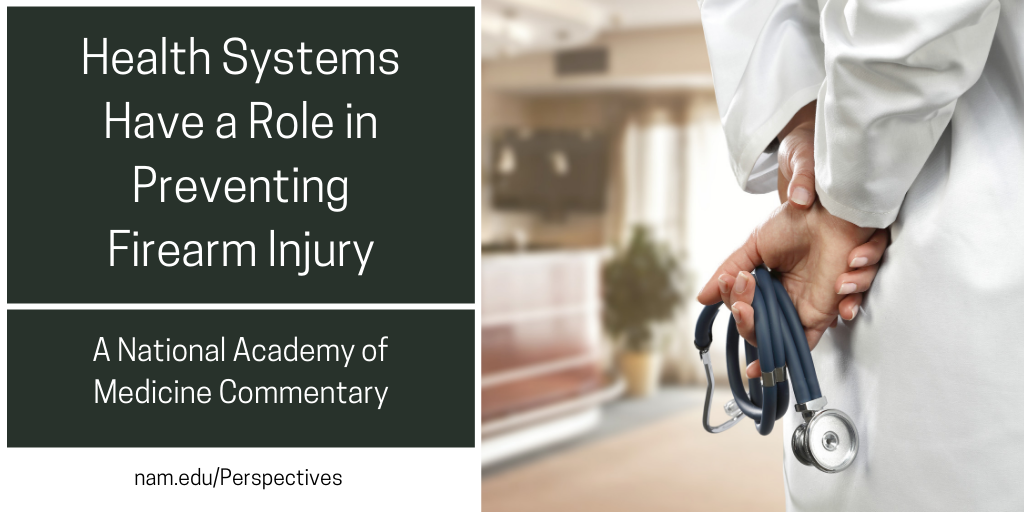Health Systems Have a Role in Preventing Firearm Injury
Every day in the United States, health professionals confront the effects of firearm injury. In emergency rooms, trauma centers, ambulatory offices, and acute care and rehabilitation facilities, health professionals and the health systems they work within attempt to heal the wounds that firearms can inflict on individuals and their families. Thus, hospitals and health systems are in a position to grasp the scope of the issue and find opportunities to prevent firearm injury and death. In 2016 and 2017, the physicians and nurses at Kaiser Permanente treated more than 11,000 gunshot victims. These 11,000 patients—from a single health system among the hundreds that operate across the United States—are a sobering reminder of the toll of firearm injury.
Firearm injury—including other-directed, self-directed, and unintentional injury and death—is a broad-based public health issue. In 2016, more than 38,000 people were killed by firearms [1]. In the same year, half of those who died by suicide used a firearm, and three-quarters of homicides involved a firearm [1]. Firearm death is the third leading cause of death for children under age 17 in the United States.
A social network analysis by Kalesan and colleagues [2] showed that almost everyone in the United States, at some point, will know someone injured or killed by a firearm. The nature of the injury varies—homicide is the more likely cause of firearm death in an urban area, whereas suicide is more likely in a rural area—but every community in every geographic region and every socioeconomic stratum is affected [3].
When we think of how many people will know someone who is injured or killed by a firearm in their lifetime, and how many will be injured directly, it is difficult to determine who or what can mitigate the impact of this massive issue. Yet hospitals and health systems will touch nearly every life in the United States at some point and are dedicated to advancing wellbeing. Few societal systems have as many touch points with an individual as health care does.
Every touch point can serve as a potential intervention before injuries occur. For instance, regular screening for depression can identify those who may be at risk of suicide. These opportunities occur in pediatrics, primary care, gynecology, geriatrics, and other specialties, as well as at different sites of care, such as hospitals, medical offices, and emergency departments. Addressing social determinants to improve the health of patients and communities also can provide a chance to protect patients from firearm injury.
To be effective, health professionals need to know how to identify those at a higher risk of firearm injury, and they need to have the tools to intervene effectively. Health systems and community-based organizations have gathered data that can be used for firearm injury prevention and improvement.
Like all public health threats, firearm injury has complex social and psychological underpinnings. However, approaching firearm injury as public health and preventive health issues provides the advantage of approaching prevention systematically and scientifically. Studying firearm injury prevention in the same way we study cancer, heart disease, and other leading causes of death could offer a better way forward.
In October 2018, Kaiser Permanente and the American Hospital Association sponsored a workshop at the National Academies of Sciences, Engineering, and Medicine [4] to examine the current state of the science and the research necessary to enable hospitals and health systems to be more effective in preventing firearm injury and death.
The workshop participants highlighted three overarching themes for hospitals and health systems to help prevent firearm injury:
- Know the epidemiology and burden of firearm injury in the communities served by your health care organization. Every community is different, and understanding the nature of the problem is key to taking steps to mitigate it.
- Invest in research that identifies those at a higher risk of firearm injury and then develop interventions to reach those individuals and communities.
- Collaborate with other organizations to develop and share best practices and evidence-based prevention programs. Despite the lack of available funding, researchers are continuing important work to prevent firearm injury across the country. Sharing that knowledge and working to add to it are crucial.
In April 2018, Kaiser Permanente dedicated $2 million to firearm injury prevention research, one of the largest contributions to this topic ever made by a health system. As federally funded research into firearm injury prevention has been lacking for more than two decades, it is critical that we consider innovative approaches to addressing firearm injury and death to accelerate this much-needed research.
This is a complicated problem without a simple solution. Yet hospitals and health systems have confronted complicated public health problems before and, through research and practice, developed and improved preventive interventions that have saved lives. As one workshop speaker noted, “When we apply the medical model of disease to this problem, I can look at it like any other health problem that has a natural history because I am seeing these patients when they first express the risk factors or when risk factors escalate. If we are able to intervene effectively, then we can prevent the shootings [4].”
Hospitals, health systems, and health care professionals have an opportunity to develop and implement firearm injury prevention and intervention programs in the same systematic and rigorous way that we have confronted other large-scale public health problems. Taking this opportunity will provide a path forward to reducing the crisis of firearm injury and death for us all.
Join the conversation!
![]() Tweet this! New from #NAMPerspectives: Health Systems Have a Role in Preventing Firearm Injury – https://doi.org/10.31478/201904c #PreventFirearmDeath
Tweet this! New from #NAMPerspectives: Health Systems Have a Role in Preventing Firearm Injury – https://doi.org/10.31478/201904c #PreventFirearmDeath
![]() Tweet this! Studying firearm injury in the same way that we study cancer could help make inroads to this crisis. More about how health care systems can work to address firearm injury as a preventative health issue: https://doi.org/10.31478/201904c #NAMPerspectives #PreventFirearmDeath
Tweet this! Studying firearm injury in the same way that we study cancer could help make inroads to this crisis. More about how health care systems can work to address firearm injury as a preventative health issue: https://doi.org/10.31478/201904c #NAMPerspectives #PreventFirearmDeath
![]() Tweet this! Every day, health professionals confront the effects of firearm injury in the clinical setting. Why firearm injury should be approached as other public health issues are: https://doi.org/10.31478/201904c #NAMPerspectives #PreventFirearmDeath
Tweet this! Every day, health professionals confront the effects of firearm injury in the clinical setting. Why firearm injury should be approached as other public health issues are: https://doi.org/10.31478/201904c #NAMPerspectives #PreventFirearmDeath
Download the graphic below and share it on social media!

References
- Centers for Disease Control and Prevention. 2019. Firearm mortality by state. Available at: https://www.cdc.gov/nchs/pressroom/sosmap/firearm_mortality/firearm.htm (accessed April 22, 2019).
- Kalesan, B., M. E. Mobily, O. Keiser, J. A. Fagan, and S. Galea. 2016. Firearm legislation and firearm mortality in the USA: A cross-sectional, state-level study. The Lancet 387(10030):1847-1855. https://doi.org/10.1016/S0140-6736(15)01026-0
- Branas, C. C., M. L. Nance, M. R. Elliott, T. S. Richmond, and C. W. Schwab. 2004. Urban-rural shifts in intentional firearm death: Different causes, same results. American Journal of Public Health 94(10):1750-1755. Available at: https://www.ncbi.nlm.nih.gov/pmc/articles/PMC1448529 (accessed April 22, 2019).
- The National Academies of Sciences, Engineering, and Medicine. 2019. Health systems interventions to prevent firearm injuries and death: Proceedings of a workshop. Washington, DC: The National Academies Press, https://doi.org/10.17226/25354

